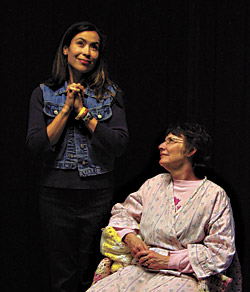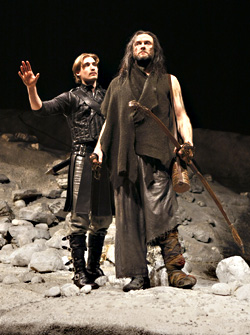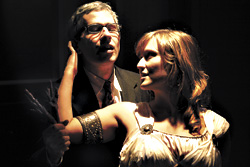When the curtain opened on her execution chamber in October of 2002, just before her lethal injection for killing at least six men, Aileen Wuornos grinned at the witnesses and said, “Yes, I’d just like to say I’m sailing with the Rock, and I’ll be back. Like Independence Day with Jesus, June 6, like the movie, big mothership and all. I’ll be back.” Now, that would be a movie!
Thanks to Ted Bundy, she is indeed backnot in a blockbuster, but in the scrappy indie feature Monster (which opens Friday, Jan. 9, at the Metro and Uptown), portrayed by an unspeakably transformed Charlize Theron. It was the video-rental success of the dreadful docudrama Bundy that got debut writer-director Nancy Jenkins’ film greenlighted; if one (crummy) low-budget serial-killer flick made money, why not risk funding one about “the first female serial killer,” as Wuornos was billed in the press?
Yet Wuornos was a different animal than the monster Bundy. He killed in order to stage the bizarre personal ritual he cravednever fully revealed by authorities, but somehow involving absolute control over cadavers, painting their faces with lurid makeup, and employing body parts as props. We don’t know why prostitute Wuornos killed the men who picked her up, beyond the obvious motives of robbery, car theft, and rather understandable generalized hostility. (When you think about it, why don’t more prostitutes kill their johns?) Wuornos never fit the profile of a serial killer, despite her subsequent fame as such.
SO INSTEAD OF portraying her as a Bundy-esque psycho killer, Jenkins and producer Theron make her a mostly sane killer driven to homicide by a psycho john. In a scene artfully balancing horror and modesty, we see Wuornos shoot a sadist after he rapes and tortures her. As depicted in Monster, the unemployable, hair-trigger Wuornos only keeps hooking, killing, and robbing in order to make a nice home for herself and her sinister young sweetheart, Selby (a fictionalized cipher of a character, played by Christina Ricci and inspired by the real girlfriend who betrayed Wuornos to the police). Throughout, Jenkins skillfully renders the blighted Florida highway-side landscape of Wuornos’ blighted life.
Meanwhile, the victims keep getting less repulsive and more pathetic, until Wuornos finally kills a nice guy who only intended to help her (he sees her gun, and she’s got to eliminate the witness). By giving Wuornos such intelligible motives, Jenkins and Theron would make her, yes, a sympathetic characterso sympathetic, perhaps, that Roger Ebert hails the film, and Theron’s performance, as the best of 2003.
But if you look at the real woman in Nick Broomfield’s 1992 documentary, Aileen Wuornos: The Selling of a Serial Killer, you see a far crazier personand also, oddly, a less ugly woman than Theron after her 30-pound weight gain and makeover by blotchy-skin makeup and protuberant prosthetic teeth. Wuornos reportedly appears madder still in Broomfield’s new follow-up, Aileen: The Life and Death of a Serial Killer, which arrives here Jan. 30. She even recants her the-sadist-rapist-made-me-do-it story, saying she just did the murders out of greed and hate.
As a result, there’s a fundamental tension here between the randomness of the real character’s life and death and the formula poignance of Theron’s character in Monster. The movie feels triply false: Wuornos becomes a woman with an essentially good heart (plus unwise but understandable motives); then she’s wronged by society and lets her temper get out of hand; and, oh, she does it all for love.
THIS HIGH-CONCEPT sentimentality limits the film, but it greatly increases its Oscar chancesparticularly for Theron. Her real-life beauty is so blandly, blondly generic that she’s often confused with other starlets; it’s better to have distinctive looks, like Julia Roberts’ big wax lips and Jimmy Carter-esque choppers, than Theron’s rather meek mug. Now she’s forced Hollywood to reconsider her talent by truly, physically losing herself in a role.
Her embodiment of Wuornosface in a permanent frown, eyes shrieking despair and Horatio Alger determination, chest thrust out, tree-trunk legs splayed, swaggering and stomping and barking like a soused stevedoreis more impressive than Ren饠Zellweger’s pudgified Bridget Jones, almost as good as Hillary Swank’s Boys Don’t Cry female-to-male transgender; it even bears comparison with De Niro in Raging Bull. She pulls off the sentimental scenes, too: When she roller-skates with Ricci, it’s sweetly romantic. When Ricci’s gold-digging character reveals herself to be the true villain of the piece, the heartbreak in Theron’s eyes melts our hearts.
So will Monster really raise Theron to the A-list elite? De Niro won new fame for his Bull bulk, but men can remain stars even when the flab isn’t for a role. Zellweger bulked up and racked up reputation enhancement, but Bridget’s plumpness only made her more adorable. Swank’s boy impersonation was phenomenalbut has anybody seen or heard from her since? There are only three ages for women in Hollywood: babe, district attorney, and Driving Miss Daisy. The 28-year-old Theron has made her name at last, but it’s going to be tricky to parlay this peculiar antibabe role into something marketable. Here’s hoping she pulls it off.








